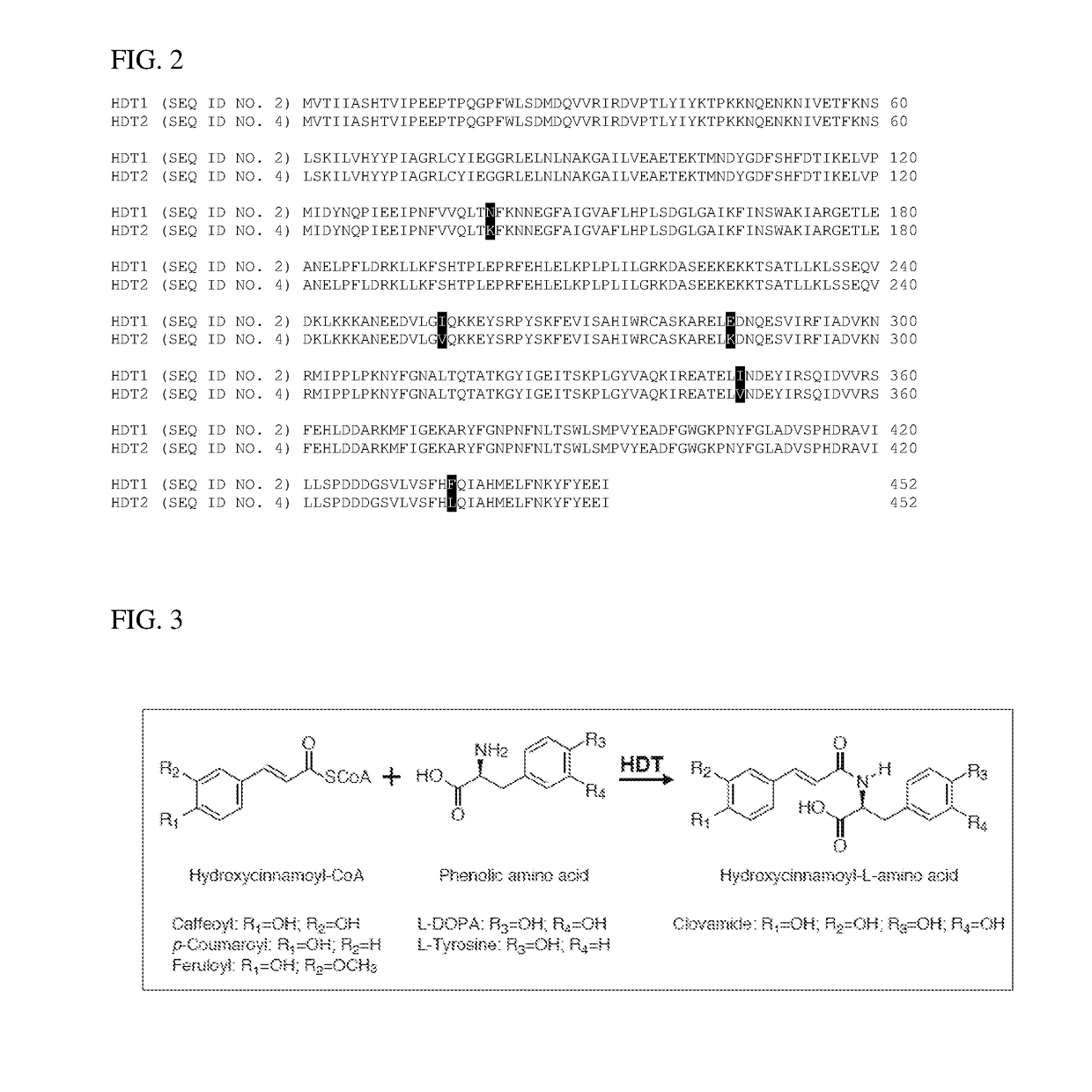Genetically altered alfalfa producing clovamide and/or related hydroxycinnamoyl amides
- Summary
- Abstract
- Description
- Claims
- Application Information
AI Technical Summary
Benefits of technology
Problems solved by technology
Method used
Image
Examples
example 1
nnamoyl-CoA:L-DOPA Hydroxycinnamoyl Transferase Activity in Red Clover Tissues
[0052]For experiments described in this and other examples herein with red clover (Trifolium pratense), a highly regenerable genotype (designated NRC7) derived from a population of NewRC germplasm (Smith and Quesenberry, 1995, Crop Sci. 35:295-295) was used. For genetically altered alfalfa (Medicago sativa), a highly regenerable clone of Regen-SY germplasm (Bingham, 1991, Crop Sci. 31:1098) was used for all examples. A collection of NRC7 red clover plants silenced for red clover hydroxycinnamoyl-CoA:malate hydroxycinnamoyl transferase (HMT, encoded by red clover HCT2) was generated as described by Sullivan and Zarnowski, 2011, using the RNAi construct described therein which contains a hairpin RNA corresponding to the region between nucleotides 481 and 1224 of GenBank sequence EU861219.
[0053]Further, for all experiments described herein, trans-p-coumaroyl-, -caffeoyl-, and -feruloyl-CoA thiolesters were pr...
example 2
f Two cDNAs Encoding Hydroxycinnamoyl-CoA:L-DOPA Hydroxycinnamoyl Transferse (HDT1 and HDT2)
[0059]Red clover total RNA was prepared from plant tissues using the RNeasy Plant Mini Kit (Qiagen, Valencia, Calif.) according to the manufacturer's recommended protocol. Oligo dT-primed cDNA was prepared using Superscript III reverse transcriptase (Invitrogen, Carlsbad, Calif.) according to the manufacturer's recommended protocol from DNase I-treated total RNA. Plasmid DNA was prepared using the QIAprep Spin Miniprep Kit (Qiagen, Valencia, Calif.) according to the manufacturer's recommended protocol. DNA sequence was determined by Sanger cycle sequencing via reactions using Big Dye v3.1 (Applied Biosystems, Foster City, Calif.). Sequencing reactions were analyzed on ABI 3730xl DNA Analyzers by the University of Wisconsin Biotechnology Center (Madison, Wis.). Sequence analyses were carried out using the Lasergene Version 8 or higher (DNAStar, Madison, Wis.), and BLAST® programs using the Nat...
example 3
n of HDT mRNA Levels in Red Clover Leaves by Reverse Transcription PCR
[0066]Expression of HDT was evaluated using semiquantitative reverse transcribed PCR using cDNA from unexpanded or mature red clover leaves as the template. PCR reactions contained 25 pmol each ms881 (SEQ ID NO: 9) and ms882 (SEQ ID NO: 10) (for detection of HDT) or ms171 (SEQ ID NO: 17) and ms172 (SEQ ID NO: 18) (for detection of actin, as a control) (see Table 3), cDNA equivalent to 50 ng total RNA, 12.5 μL EconoTaq Plus Green Mastermix (Lucigen Corp., Middleton, Wis.) and water to make 25 μL. Reactions were incubated for 30 sec at 94° C. in the block of a thermocycler. This incubation was followed by 25 cycles of 94° C. for 20 sec (denaturation), 64° C. for 20 sec (annealing), and 72° C. for 30 sec (extension) followed by a final 2 min extension at 72° C. 3 μL of the PCR reactions were resolved via electrophoresis on a 1.5% agarose gel using standard techniques.
[0067]HDT expression was much higher in unexpanded...
PUM
| Property | Measurement | Unit |
|---|---|---|
| Fraction | aaaaa | aaaaa |
Abstract
Description
Claims
Application Information
 Login to View More
Login to View More - R&D
- Intellectual Property
- Life Sciences
- Materials
- Tech Scout
- Unparalleled Data Quality
- Higher Quality Content
- 60% Fewer Hallucinations
Browse by: Latest US Patents, China's latest patents, Technical Efficacy Thesaurus, Application Domain, Technology Topic, Popular Technical Reports.
© 2025 PatSnap. All rights reserved.Legal|Privacy policy|Modern Slavery Act Transparency Statement|Sitemap|About US| Contact US: help@patsnap.com



